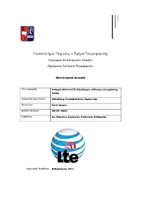Ασύρματα δίκτυα LTE: αξιολόγηση επίδοσης κατερχόμενης ζεύξης

Master Thesis
Author
Παπαδάκης, Χρυσοβαλάντης - Εμμανουήλ Χ.
Date
2014-04-29Advisor
Βέργαδος, ΔημήτριοςView/
Abstract
The scope of the present master thesis is the study and the analysis of the LTE networks, which constitute the latest technology evolution of the fourth generation of wireless mobile communication networks. The thesis consists of two sections, the theoretical and the practical one. Firstly, there is a reference to the historical background and evolution of mobile communication networks from the first generation networks to the current fourth generation ones. There follows an analysis of the technological standard, its architecture and its layers, especially the physical layer and the mac layer. Then, several algorithms for power control and various techniques for mitigating intercell interference are presented. Furthermore, in the framework of the present Master Thesis the performance of an LTE network has been assessed with the use of the Matlab software.The scope was the study of the behavior and variation of the bit error rate measurement, in order to assess the reliability of the system; the study and variation of the throughput measurement, in order to evaluate the data traffic that can be transferred via the channel and the study and variation of the Shannon capacity measurement, in order to define the maximum possible reliable transmission rate via the channel. More specifically, a simulation has been developed based on the specifications of LTE-TDD only in the case of Downlink. That is, in the case that the base station is serving a mobile terminal and specifically when the terminal uses a single resource (SU-MIMO). This technique is applied only to the Physical Downlink Shared Channel (PDSCH), which is a physical layer channel. As for the transmission mode, the simulator supports only the case of Spatial Multiplexing. The modulation schemes which are supported are the 4QAM, 16QAM και 64QAM. It is worth pointing out the variation of options that are available for the user through the application in order to assess the results and reach conclusions with regard to multiple cases and multiple scenarios of mobile communications of this specific technological standard.


